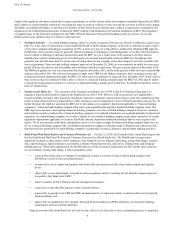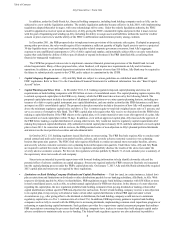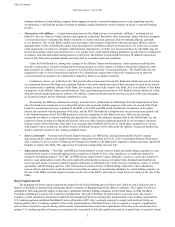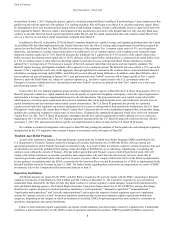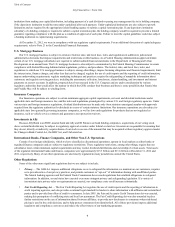Ally Bank 2012 Annual Report Download - page 17
Download and view the complete annual report
Please find page 17 of the 2012 Ally Bank annual report below. You can navigate through the pages in the report by either clicking on the pages listed below, or by using the keyword search tool below to find specific information within the annual report.15
on its ability to pay dividends. The bank regulators have the authority and, under certain circumstances, the duty to prohibit or to limit
payment of dividends by the banking organizations they supervise, including Ally Financial Inc. and its subsidiaries.
Current and future increases in FDIC insurance premiums, including the FDIC special assessment imposed on all FDIC-insured
institutions, could decrease our earnings.
Beginning in 2008 and continuing through 2012, higher levels of bank failures have dramatically increased resolution costs of the FDIC
and depleted the Deposit Insurance Fund (the DIF). In May 2009, the FDIC announced that it had voted to levy a special assessment on
insured institutions in order to facilitate the rebuilding of the DIF. In September 2009, the FDIC voted to adopt an increase in the risk-based
assessment rate effective beginning January 1, 2011, by three basis points. Further, the Dodd-Frank Act alters the calculation of an insured
institution’s deposit base for purposes of deposit insurance assessments and removes the upper limit for the reserve ratio designated by the
FDIC each year. On February 7, 2011, the FDIC approved a final rule implementing these changes, which took effect on April 1, 2011. The
FDIC will continue to assess the changes to the assessment rates at least annually. Future deposit premiums paid by Ally Bank depend on the
level of the DIF and the magnitude and cost of future bank failures. Any increases in deposit insurance assessments could decrease our
earnings.
Risks Related to Our Business
The profitability and financial condition of our operations are heavily dependent upon the performance, operations, and prospects of
GM and Chrysler.
GM and Chrysler dealers and their retail customers compose a significant portion of our customer base, and our Dealer Financial
Services operations are highly dependent on GM and Chrysler production and sales volume. In 2012, 63% of our U.S. new vehicle dealer
inventory financing and 59% of our U.S. new vehicle consumer automotive financing volume were for GM franchised dealers and customers,
and 28% of our U.S. new vehicle dealer inventory financing and 32% of our U.S. new vehicle consumer automotive financing volume were
for Chrysler dealers and customers.
We are currently party to agreements with each of GM and Chrysler that provide for certain exclusivity privileges related to subvention
programs offered by each of them. On April 25, 2012, Chrysler provided us with notification of nonrenewal for the existing agreement, and as
a result our agreement with Chrysler will expire in April 2013. Further, Chrysler has recently announced that it has entered into a ten-year
agreement with Santander Consumer USA Inc. (Santander), pursuant to which Santander will provide a full range of wholesale and retail
financing services to Chrysler dealers and consumers, beginning in May 2013. In addition, our agreement with GM will expire in December
2013. These agreements provided Ally with certain preferred provider benefits, including limiting the use of other financing providers by GM
and Chrysler in their incentive programs. We cannot predict the ultimate impact that the expiration of these agreements will have on our
operations. However, the expiration of these agreements will likely increase competitive pressure on Ally, as some competitors have or could
have exclusive agreements with GM and/or Chrysler.
On October 1, 2010, GM acquired AmeriCredit Corp. (which GM subsequently renamed General Motors Financial Company, Inc.
(GMF)), an independent automotive finance company that focuses on providing leasing and subprime financing options. Further, and as
previously announced, we have entered into an agreement with GMF pursuant to which GMF will purchase our automotive finance
operations in Europe and Latin America, as well as our interest in a joint venture in China. As GMF continues to grow, and as GM directs
additional business to GMF, it could reduce GM's reliance on our services over time, which could have a material adverse effect on our
profitability and financial condition. In addition, it is possible that GM or other automotive manufacturers could utilize other existing
companies to support their financing needs including offering products or terms that we would not or could not offer, which could have a
material adverse impact on our business and operations. Furthermore, other automotive manufacturers could expand or establish or acquire
captive finance companies to support their financing needs thus reducing their need for our services.
A significant adverse change in GM’s or Chrysler’s business, including the production or sale of GM or Chrysler vehicles; the quality or
resale value of GM or Chrysler vehicles; the use of GM or Chrysler marketing incentives; GM’s or Chrysler’s relationships with its key
suppliers; or GM’s or Chrysler’s relationship with the United Auto Workers and other labor unions and other factors impacting GM or
Chrysler or their respective employees, or significant adverse changes in their respective liquidity position and access to the capital markets;
could have a material adverse effect on our profitability and financial condition.
There is no assurance that the global automotive market or GM’s and Chrysler’s respective share of that market will not suffer downturns
in the future, and any negative impact could in turn have a material adverse effect on our business, results of operations, and financial
position.
Our business requires substantial capital and liquidity, and disruption in our funding sources and access to the capital markets would
have a material adverse effect on our liquidity, capital positions, and financial condition.
Our liquidity and the long-term viability of Ally depend on many factors, including our ability to successfully raise capital and secure
appropriate bank financing. We are currently required to maintain a Tier 1 leverage ratio of 15% at Ally Bank, which will require that Ally
maintain substantial equity funds in Ally Bank and inject substantial additional equity funds into Ally Bank as Ally Bank’s assets increase
over time.
Table of Contents
Ally Financial Inc. • Form 10-K


